Organic architecture is based on a set of conceptual ideas about designing in greater harmony with nature. At its core, it is a philosophical approach that views buildings as living, integrated elements within our environments.
Key Takeaways
- Organic architecture integrates with nature, enhancing harmony.
- Uses natural forms and materials, fostering environmental connection.
- Promotes sustainability and ecological awareness in design.
- Adaptable, reflecting local conditions and cultural context.
- Focuses on wholeness, interrelationships in design process.

Here are some beautiful organic architecture concept ideas:
1. Desert Oasis concept
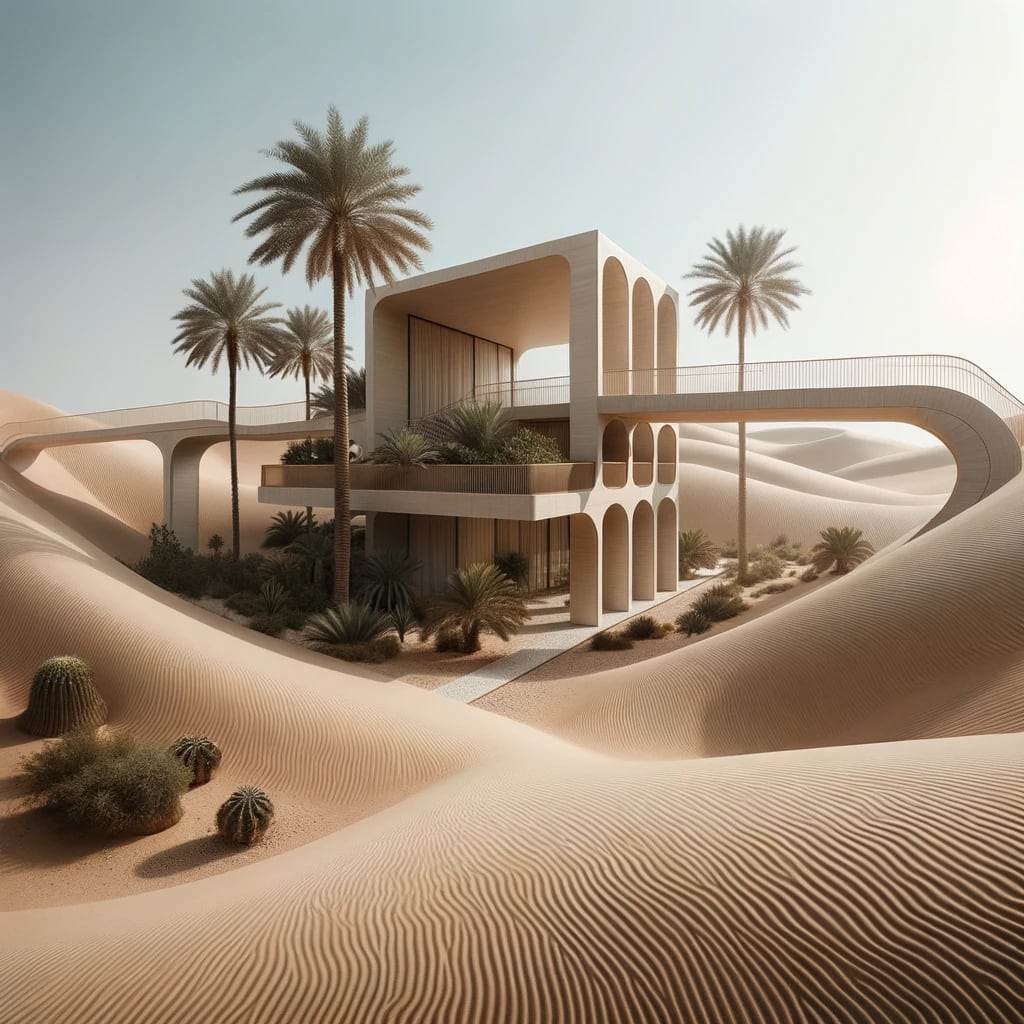
This design beautifully integrates with the desert landscape. The flowing, undulating architecture mirrors the natural curves of sand dunes.
The use of earth-toned materials helps the structure blend seamlessly into its surroundings, and the inclusion of palm trees and other desert flora adds authenticity, making the home appear as if it’s truly a part of the desert.
2. Urban Lotus Tower

Rising majestically amidst a bustling cityscape, the Urban Lotus Tower is a testament to the concept of organic architecture in urban settings.
Its design, reminiscent of petals stacked upon one another, offers a refreshing contrast to the conventional rectangular skyscrapers that dominate most city horizons.
The building’s spiraling layers, adorned with green terraces, mimic the growth patterns found in nature and emphasize sustainability.
This architectural marvel not only challenges the norms of urban construction but also serves as a beacon of harmony between nature and human habitation.
3. Forest Oasis
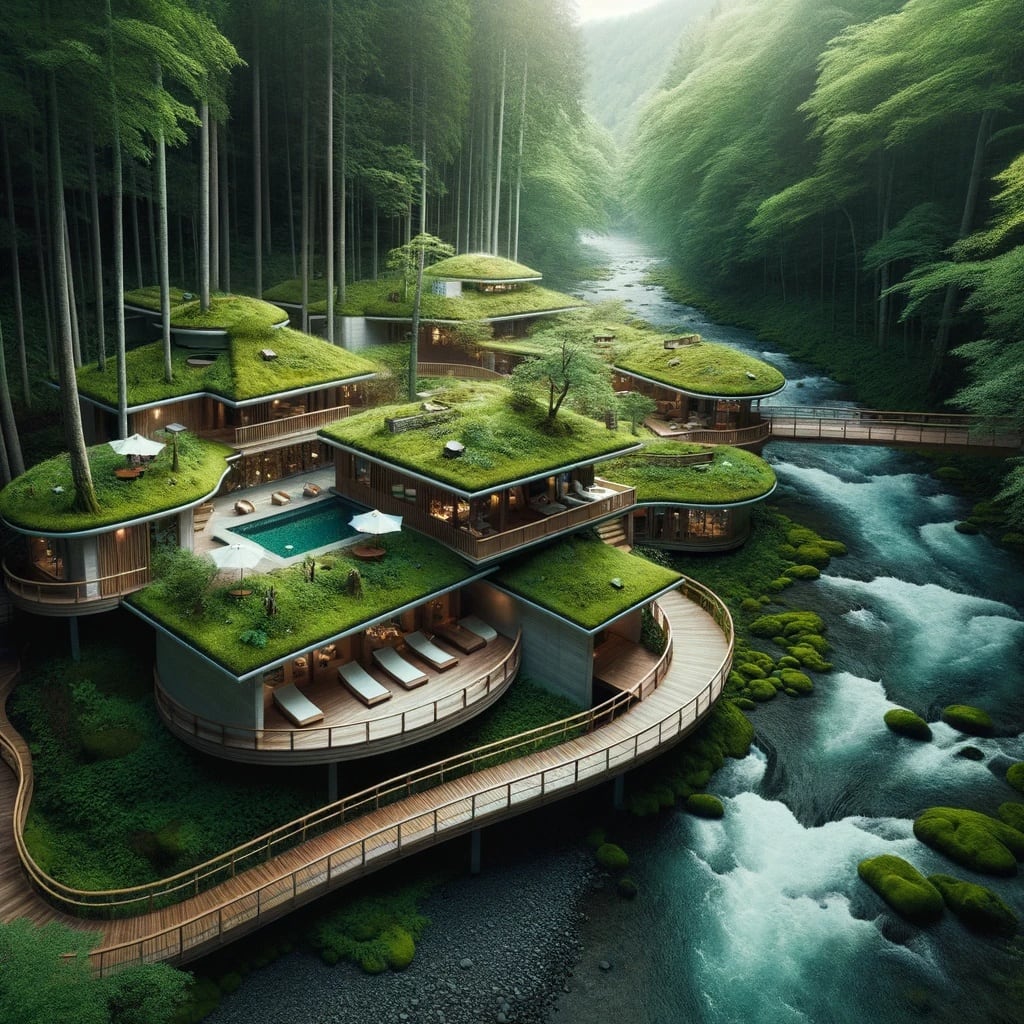
Nestled deep within the heart of the forest, this architectural marvel seamlessly blends with its verdant surroundings, exemplifying the principles of organic architecture.
Every aspect, from its grassy roofs to the flowing waterways, mirrors nature’s rhythm, fostering a tranquil retreat that promises serenity and balance with the environment.
4. Terracotta Village

This cascading village, constructed from terracotta and earthy materials, pays homage to the principles of organic architecture.
Its design seems to grow out of the hillside itself, creating an intimate relationship between the built environment and the natural landscape.
The undulating patterns and terraced structures evoke memories of ancient civilizations, yet it remains rooted in modern design sensibilities.
5. Desert Mirage

Emerging like a mirage from the vast desert sands, this futuristic abode is a testament to the adaptability of organic architecture.
Its sinuous form and curved openings mimic the shape of the dunes and palms surrounding it, while the elevated design ensures minimal disturbance to the natural terrain below.
The structure, though contemporary, beautifully marries the raw essence of the desert with the finesse of modern living.
6. Mountain Crescent Abode
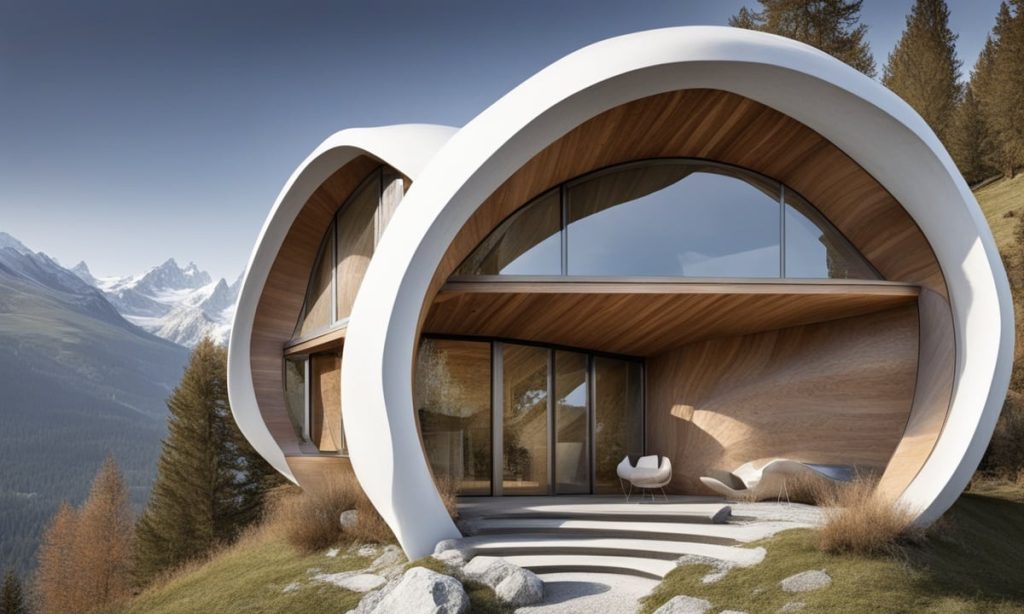
This captivating structure embodies the very essence of organic architecture. Seamlessly merging with its alpine surroundings, the curvilinear design of the building mirrors the undulating curves of nature.
The juxtaposition of sleek, modern white surfaces with the warm, textured wooden interiors pays homage to both the snow-capped peaks and the dense forests of the region.
The home is not just a dwelling, but an extension of the landscape, creating a harmonious balance between man-made structures and the natural world.
7. Blossoming Lotus Pavilion

The “Blossoming Lotus Pavilion” is a majestic example of organic architecture, where design principles mirror the natural world.
This structure, reminiscent of an unfolding lotus flower, uses smooth curves and gentle slopes to mimic the petals of the flower.
The choice of white and soft grays for its facade is in harmony with the surrounding water, giving it an ethereal appearance.
Its integration with the water through the intricate pathways further blurs the lines between the man-made and the natural, emphasizing a harmonious coexistence.
8. Riverside Forest Retreat

Elevated amidst a lush forest, this multi-layered edifice resonates with organic architectural brilliance. Its tiered design, combined with abundant green terraces, provides the sensation of an ever-climbing garden.
The integration of the building with the natural curve of the river below accentuates the symbiotic relationship between the built and natural environments, culminating in a tranquil sanctuary of harmonious coexistence.
9. Sculpted Beachfront Oasis

“Sculpted Beachfront Oasis” represents the pinnacle of organic architecture by seamlessly blending with its beach environment.
Drawing inspiration from ocean waves and seashells, the undulating form of the buildings flows harmoniously with the contours of the landscape.
The muted color palette used integrates effortlessly with the sands below and the skies above.
Expansive glass windows open the interiors to the vast expanse of the sea, ensuring that occupants always feel one with nature.
The meticulous design, from the winding pathways to the starfish-like lounges, showcases a deep respect and understanding of the environment in which it resides.
10. Oceanic Wooden Waves

Perched above the vast expanse of the ocean, this design embodies the fluidity and rhythm of waves through its graceful wooden arches.
The sprawling ceiling, reminiscent of undulating dunes or smooth coral formations, plays with light and shadow, capturing the essence of marine life.
The minimalistic furniture, combined with the vastness of the space, allows the architectural forms to take center stage, solidifying its stance as a masterpiece of organic architecture.
11. Ancient Echoes
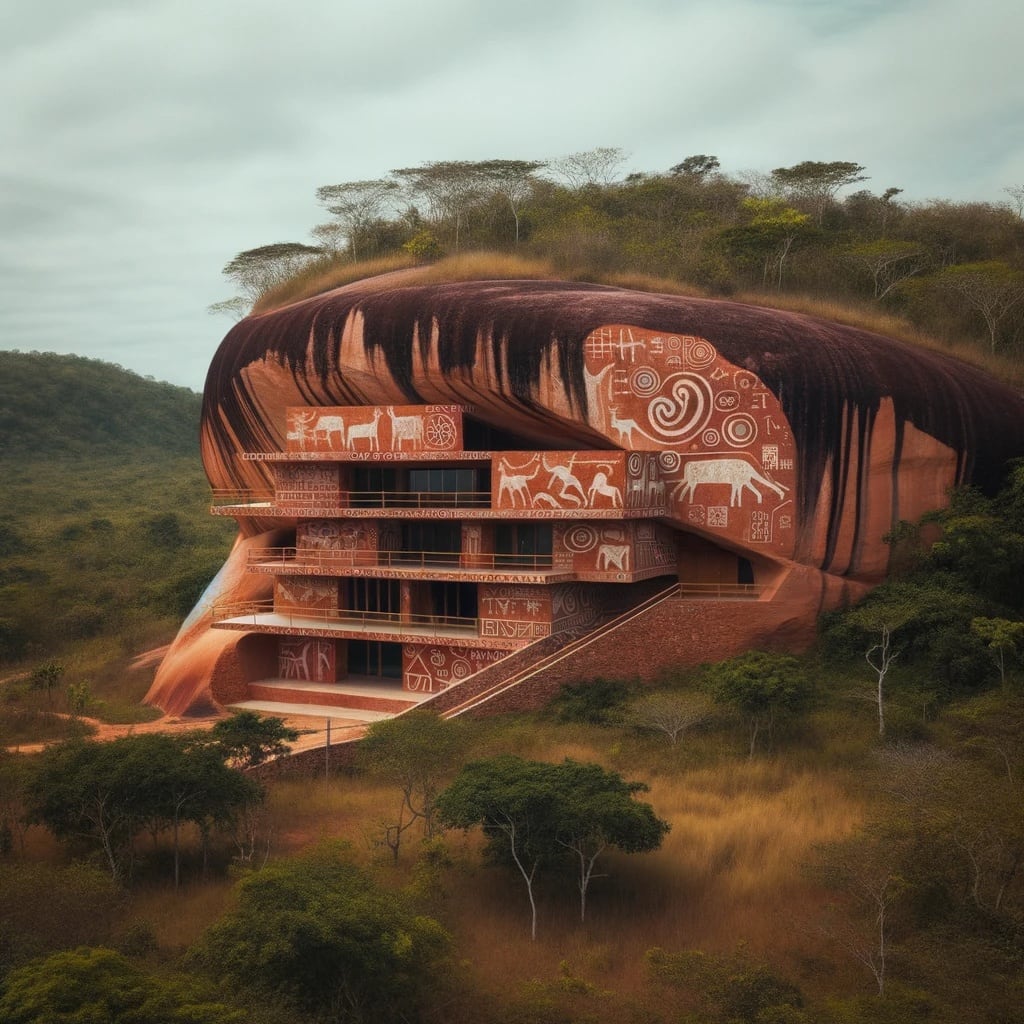
This building exudes the principles of organic architecture with a harmonious integration of nature and design.
Titled “Ancient Echoes,” the structure mimics the organic curves of the surrounding landscape, while the intricate cave paintings and tribal motifs echo ancient cultures and humanity’s symbiotic relationship with nature.
Its rusted hues blend seamlessly with the surrounding earth, suggesting a structure carved from the land itself.
12. Coastal Curves

“Coastal Curves” aptly captures the fluidity and serenity of the second image. This beachfront marvel exemplifies organic architecture, as its wavy, undulating balconies and terraces mimic the rhythmic ebb and flow of the ocean waves below.
The use of soft blues and whites mirrors the colors of the sea and sky, creating a harmonious bond between the building and its coastal environment.
The abundant greenery further integrates nature into the design, making the structure seem like an extension of the landscape.
13. Forest Curve Residence

Nestled within the heart of a dense forest, the “Forest Curve Residence” stands as a testament to the union of nature and architectural marvel.
Its fluid and curvaceous structure, reminiscent of nature’s own creations, contrasts beautifully with the rigid lines of the tall pine trees that surround it.
This residence not only offers a luxurious shelter but also blurs the boundaries between the man-made and the natural.
14. Urban Oasis

Rising majestically in the heart of the city, this structure defies conventional architectural norms with its organic, amoeba-like design.
Lush green terraces at various levels give the impression of a vertical garden, challenging the stark urban landscape surrounding it.
The building, with its intricate web of balconies and greenery, serves as a testament to the perfect marriage of urban living and environmental sustainability.
15. Waterside Whimsy

This dreamy abode paints a picturesque scene with its graceful, sweeping curves hugging the tranquil blue pond below.
The architectural design draws inspiration from flowing water, with its layered balconies resembling ripples expanding outward.
The juxtaposition of the warm wooden accents against the cool white structure adds to its allure, making it a perfect retreat for those seeking solace in nature’s embrace.
16. Floral Oasis

A surreal vision of a cityscape that seamlessly integrates organic and architectural elements.
Reminiscent of a blossoming lotus in the midst of a serene pond, the central edifice stands as an epitome of organic architecture. The building, with its petal-like structures, is surrounded by water lilies and pathways that mimic the natural curves of a meandering stream.
With smaller domed structures dotting the landscape and a verdant forest in the background, this design is a harmonious blend of nature and human ingenuity.
17. Waves of Serenity

A modern coastal residence that draws its inspiration from the undulating waves of the ocean.
This building, with its fluid and wavy form, seems to rise and fall like the tides, offering a unique example of organic architecture.
The curves of the structure mirror the waves crashing onto the shore, and its open interiors allow a seamless interplay of light and shadow.
The minimalist design, combined with natural wooden elements and a serene pool, offers a tranquil space that embodies the spirit of the sea.
18. Enchanted Forest Bridge

This mesmerizing depiction showcases the quintessence of organic architecture. The bridge, which appears to be a naturally fallen tree, seamlessly melds with its verdant surroundings.
Its intricate hollows and gnarls speak of the timelessness of nature, while its smooth pathway invites travelers to tread softly upon its back.
The surrounding lush forest and serene river beneath amplify the bridge’s tranquil allure, reminding us of the harmonious relationship that can exist between man-made structures and the natural world.
19. Coastal Cave Dwelling

The epitome of organic architecture is captured in this beachside haven. Carved seemingly by the winds and waves themselves, the dwelling mirrors the undulating forms of sand dunes and ocean waves.
The fluid contours of its wooden ceiling mirror patterns left by the retreating tide, while the vast ocean-view window serves as a reminder of the world outside.
The interior, adorned with earth-toned furnishings, exudes a sense of tranquility, offering a sanctuary where nature’s rhythms and human existence are intertwined in perfect harmony.
20. Blossom Retreat

The “Lotus Blossom Retreat” epitomizes the principles of organic architecture by harmoniously integrating the built environment with its natural surroundings. Drawing inspiration from the delicate form of a lotus flower, the structure showcases petals that unfurl, providing shelter and elegance simultaneously.
These petals, made from what appears to be weathered wood, resonate with the trees and natural elements surrounding the edifice, creating an uninterrupted flow between the interior and exterior.
The serene water body encircling the structure further accentuates this connection, with lily pads and blooming flowers enhancing the aesthetic and thematic cohesion. The generous use of wood and glass in the interior fosters a warm and inviting atmosphere while ensuring that inhabitants remain constantly connected to the verdant outdoors.
This design, in essence, becomes a seamless blend of nature and architecture, where each element complements and enhances the other.
21. Blooming Urban Oasis

This captivating structure is a prime example of organic architecture, a design philosophy that seeks to harmonize the built environment with the natural world.
Drawing inspiration from the gentle curves and forms of nature, the building evokes the imagery of a blossoming flower or a set of unfolding petals.
The soft, undulating curves contrast starkly with the rigid lines and boxes of traditional urban buildings.
The addition of green spaces on each floor, resembling the layers of a plant, emphasizes a symbiotic relationship between architecture and nature. Not only does this design provide aesthetic appeal, but it also promotes sustainability and a deeper connection with the environment.
22. Seashell Sanctuary
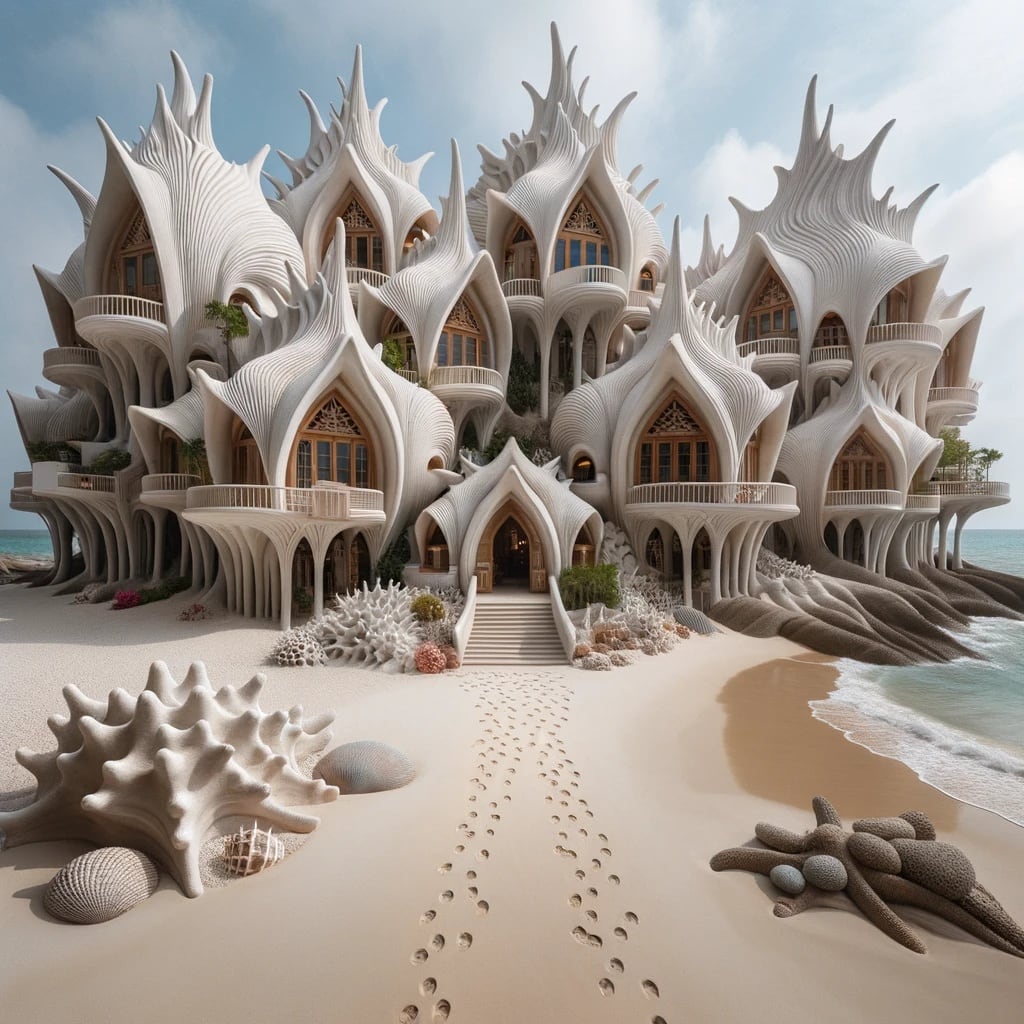
The “Seashell Sanctuary” stands as a testament to the wonders of organic architecture, drawing profound inspiration from the sea and its myriad treasures. Each segment of the edifice evokes the undulating forms of marine shells, gracefully spiraling upwards and intertwining to create a series of interlocking spaces.
The whitewashed, textured facade mimics the patterns and striations found on natural shells, allowing the building to appear as if it has been sculpted by the ocean’s hands. Adding to its beach-inspired theme, the surrounding landscape is peppered with sand, seashells, and sea flora.
The structure’s many windows, resembling the openings of sea caves, allow inhabitants to enjoy panoramic views of the nearby coast, reinforcing the building’s deep connection to its maritime environment.
By harnessing the inherent beauty of marine life, this architectural masterpiece seamlessly marries the built environment with the organic rhythms and patterns of the sea.
23. Oceanic Wave Oasis
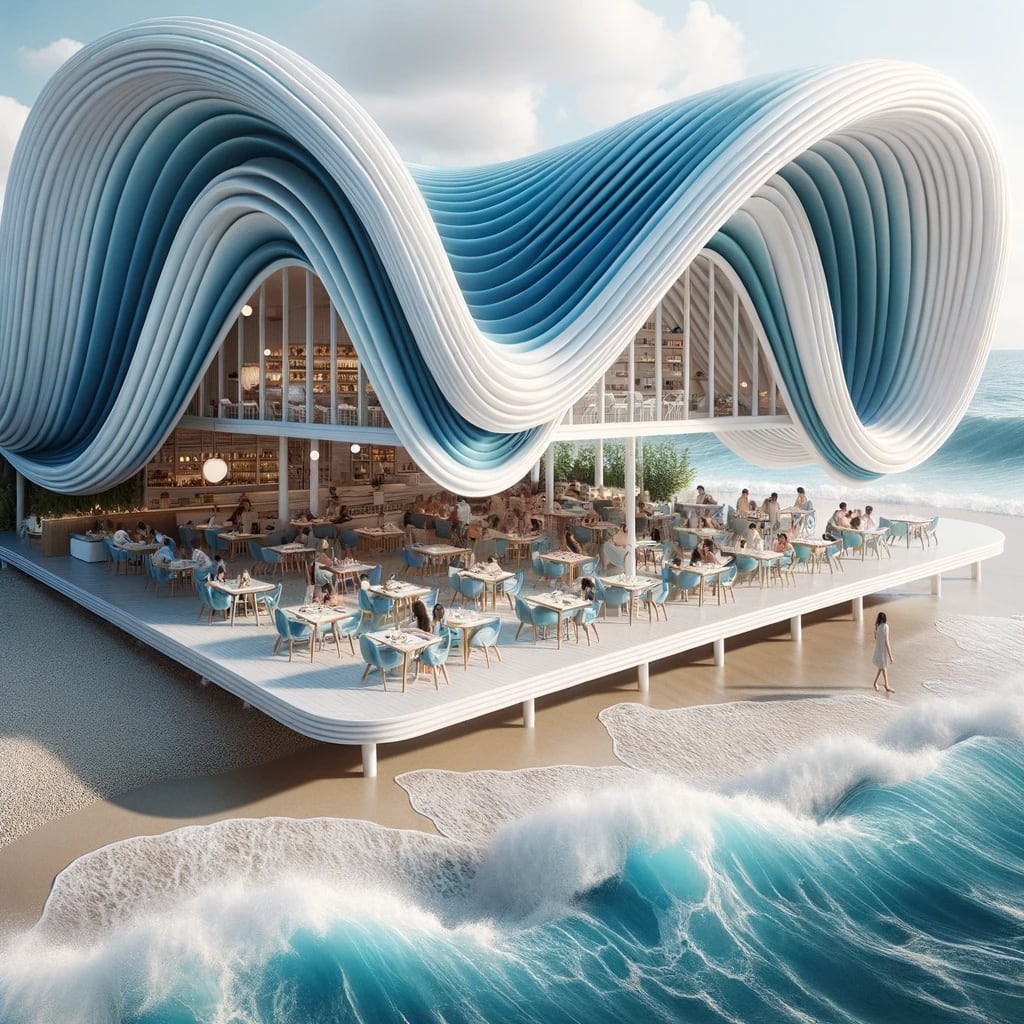
Drawing inspiration from the waves of the sea, this mesmerizing structure epitomizes organic architecture through its undulating forms and rhythmic patterns.
The building seems to rise and fall like the tides, harmoniously integrating with the oceanic backdrop.
The use of cool, blue-toned colors further enhances the maritime essence, while the open design promotes a sense of unity between nature and built form.
24. Forest Haven Resort

This ethereal design exemplifies organic architecture at its finest. The structure, nestled amidst dense pine trees, emanates the curves and fluidity of nature, mirroring the rolling hills and contours of the landscape.
The seamless blend of the edifice with its verdant surroundings ensures minimal disruption, embodying the philosophy of organic architecture that structures should be symbiotic with their environment.
25. Astral Island Enclave

Drawing direct inspiration from the oceanic ecosystem, the Astral Island Enclave is a testament to organic architecture’s ability to mirror nature’s forms.
The structures, reminiscent of white corals, are interconnected, much like a reef, providing shelter and luxury while paying homage to their aquatic neighbors, particularly the starfish that dot the island.
The deliberate use of curves, open terraces, and abundant greenery ensures that the enclave doesn’t just sit on the environment but is a part of it, exuding a sense of belonging and symbiosis.
26. Sculpted Horizon Resort
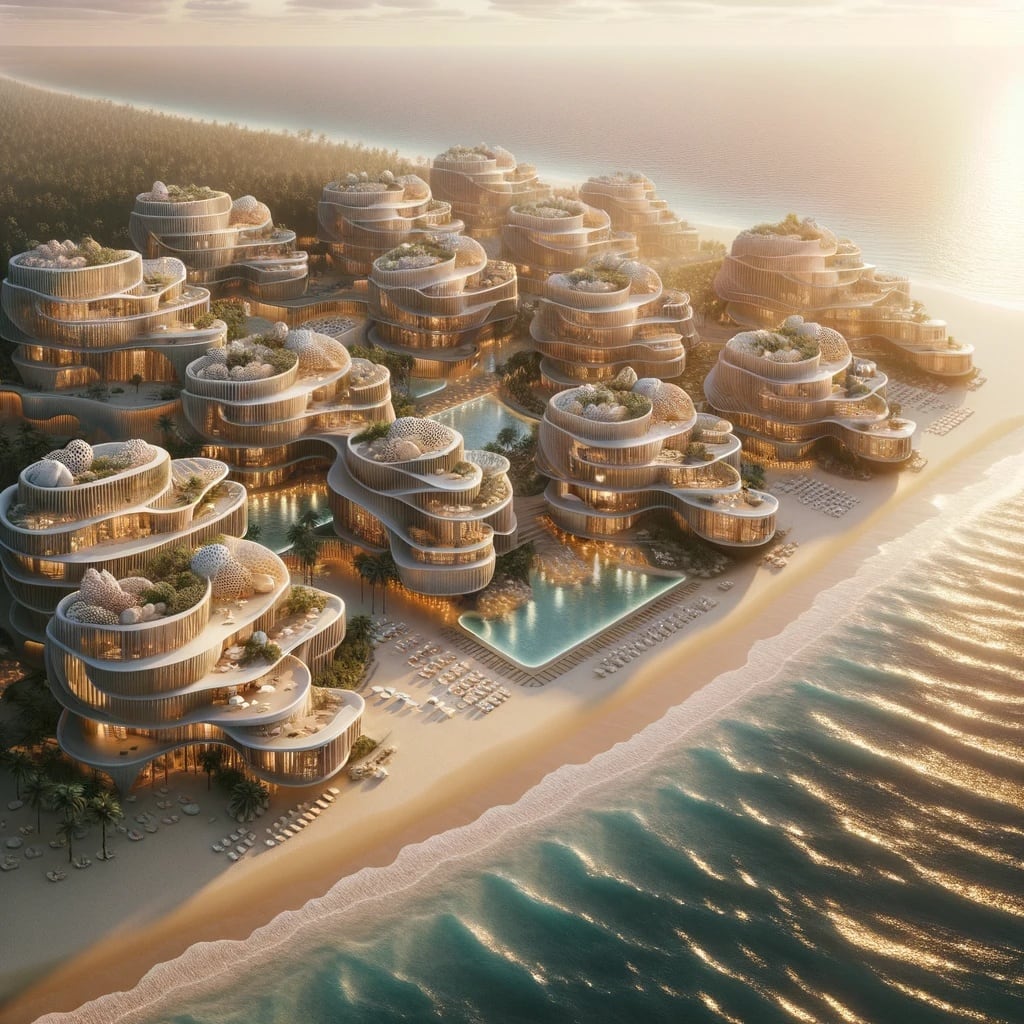
The Sculpted Horizon Resort exemplifies the principles of organic architecture by harmoniously integrating the structure into its coastal surroundings.
The cascading terraces, adorned with lush greenery, mimic the rolling dunes and provide a seamless transition from the built environment to the natural one.
The use of wooden materials and rounded architectural features not only evokes a sense of natural growth and evolution but also offers a gentle, flowing contrast to the straight horizon of the sea.
27. Volcanic Fluidity

This image presents a masterful illustration of organic architecture, seamlessly merging the building with its volcanic surroundings. Every curve, twist, and undulation of the structure mimics the free-flowing lava once present, creating a sense of movement even in stillness.
The choice of dark textures intertwined with patches of green mirrors the sporadic vegetation that finds its way among volcanic rocks.
The inclusion of natural light through strategically placed openings further enhances its organic appeal.
28. Forest Cathedral

The Forest Cathedral showcases a serene blend of man-made structure and the majesty of nature. The lofty wooden beams, arranged in a symmetrical pattern, echo the towering pine trees visible through the expansive glass windows.
The natural grain of the wood and the stone wall ground the space in an earthy palette, reinforcing its connection to the surrounding forest. It’s as if the room is an extension of the forest itself, blurring the line between inside and outside.
The abundance of natural light pouring in further intensifies the feeling of being one with nature.
29. Serpentine Hillside Residence

The “Serpentine Hillside Residence” is a masterclass in organic architecture. Merging seamlessly with the verdant hillside, its sinuous, multi-layered design mimics the natural contours of the land.
The abundant use of green roofs not only reduces the visual impact of the structure but also offers environmental benefits. Expansive glass walls bring the outside in, allowing residents to feel as though they are living within the landscape rather than merely on it.
30. Mountain Embrace

This architectural masterpiece integrates seamlessly into its alpine environment. The multi-tiered wooden structure is designed with sloping roofs and wide glass panels, allowing for panoramic views of the majestic mountain backdrop.
The natural timber facade harmoniously blends with the mountain’s contours, embodying the essence of organic architecture by respecting and echoing its surroundings.
With its subtle geometric form juxtaposed against the rugged mountain terrain, this dwelling is a testament to the fusion of human design and nature’s grandeur.
31. Coastal Timber Cocoon

The “Coastal Timber Cocoon” is an embodiment of organic architecture’s principles. Drawing inspiration from the fluidity and malleability of wood, its undulating wooden curves form cavernous spaces reminiscent of natural formations carved by the elements.
The warm, wooden interiors create an atmosphere of serenity, and the strategic openings frame stunning views of the sea, making inhabitants feel as though they’re ensconced in a timber sanctuary sculpted by nature’s hands.
32. Seashell Haven

The Seashell Haven stands as a testament to organic architecture’s ability to seamlessly integrate human-made structures with the natural environment. Its design is reminiscent of sea shells, with each unit sculpted to mirror the curves and flows of the waves crashing upon the nearby shore.
The harmonious blend of white, porous facades against the backdrop of palm trees and azure waters exemplifies a symbiotic relationship between the building and its tropical surroundings.
33. Seashell Seaside Retreat
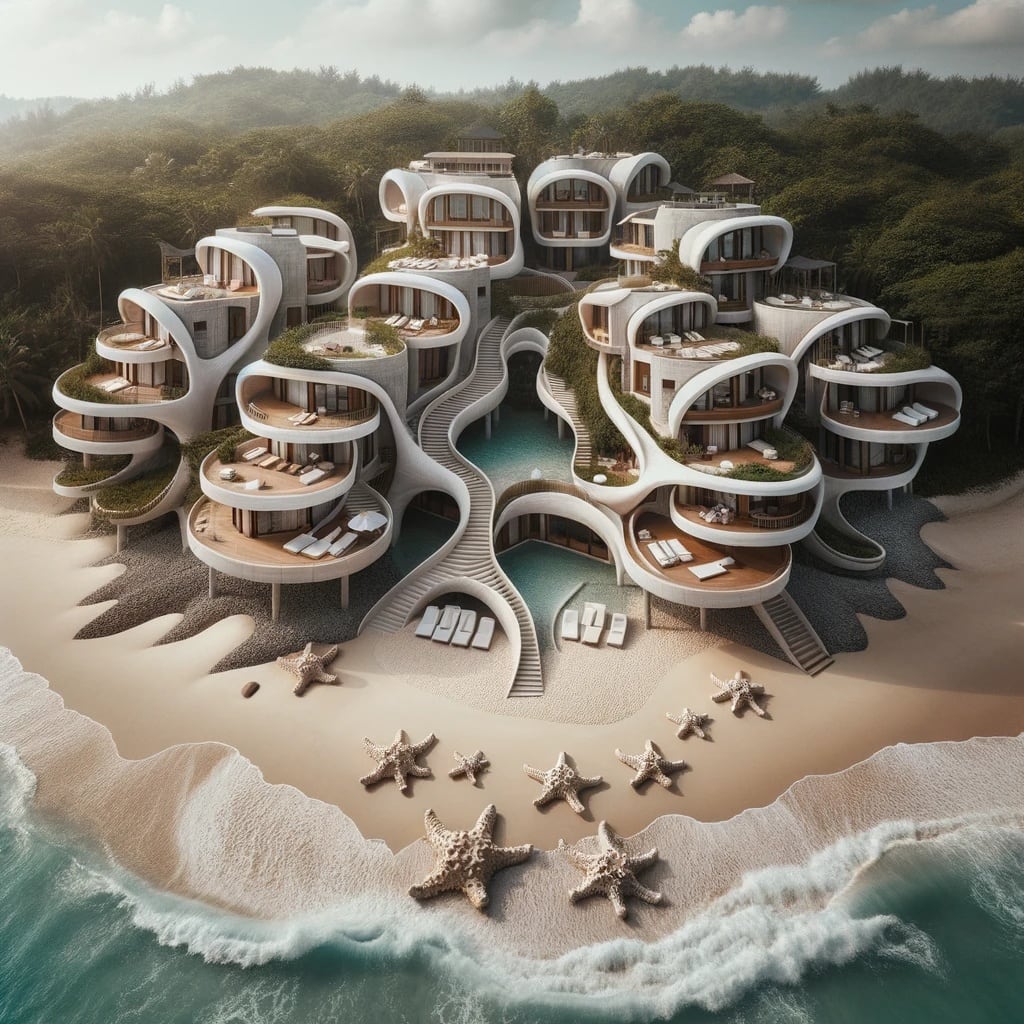
This enchanting coastal retreat is a prime example of organic architecture. Seamlessly integrating with the surrounding nature, the structure evokes the undulating waves of the sea with its flowing lines and spiraled curves.
The buildings, which resemble interlocked seashells, seem to rise naturally from the sandy shores, merging effortlessly with the lush forest behind them.
The serene harmony of the water, sand, and structures makes this sanctuary a testament to the symbiotic relationship between the built environment and nature.
34. Luminescent Canopies

Set in an urban landscape, this architectural wonder takes inspiration from nature’s own creations.
The illuminated mushroom-like structures stand tall, exuding a serene, ethereal glow. Their curvilinear forms, reminiscent of large fungi or deep-sea organisms, invite visitors into a world where man-made design imitates organic growth patterns.
The choice of soft, radiant lighting accentuates the structures’ naturalistic appeal, making them not just functional elements, but also awe-inspiring art installations.
This design epitomizes organic architecture, where the built environment harmoniously coexists with its organic inspirations.
35. Forest Canopy Haven

Nestled amongst the towering redwoods, the “Forest Canopy Haven” epitomizes organic architecture at its finest.
With structures that seamlessly blend into the tree trunks, this multilevel dwelling looks as if it has grown organically from the tree itself. Curved balconies mimic the natural contours of the trees, while the lush greenery on the terraces enhances its symbiotic relationship with nature.
The wooden tones coupled with the gentle cascade of a waterfall below further accentuate the harmony between architecture and the environment.
36. Hieroglyphic Mountain Mansion

Carved into the heart of a towering cliff, this structure pays homage to ancient civilizations while embodying the principles of organic architecture.
The dwelling seems to have been sculpted by nature itself, its form echoing the contours and colors of the rocky surroundings. Embellished with hieroglyphs, it tells a story of times long past, merging history with the present.
The way it nestles into the landscape, using the overhang for shelter and the stone’s natural insulating properties, emphasizes a deep-rooted connection to the earth.
37. Forested Serenity Villa
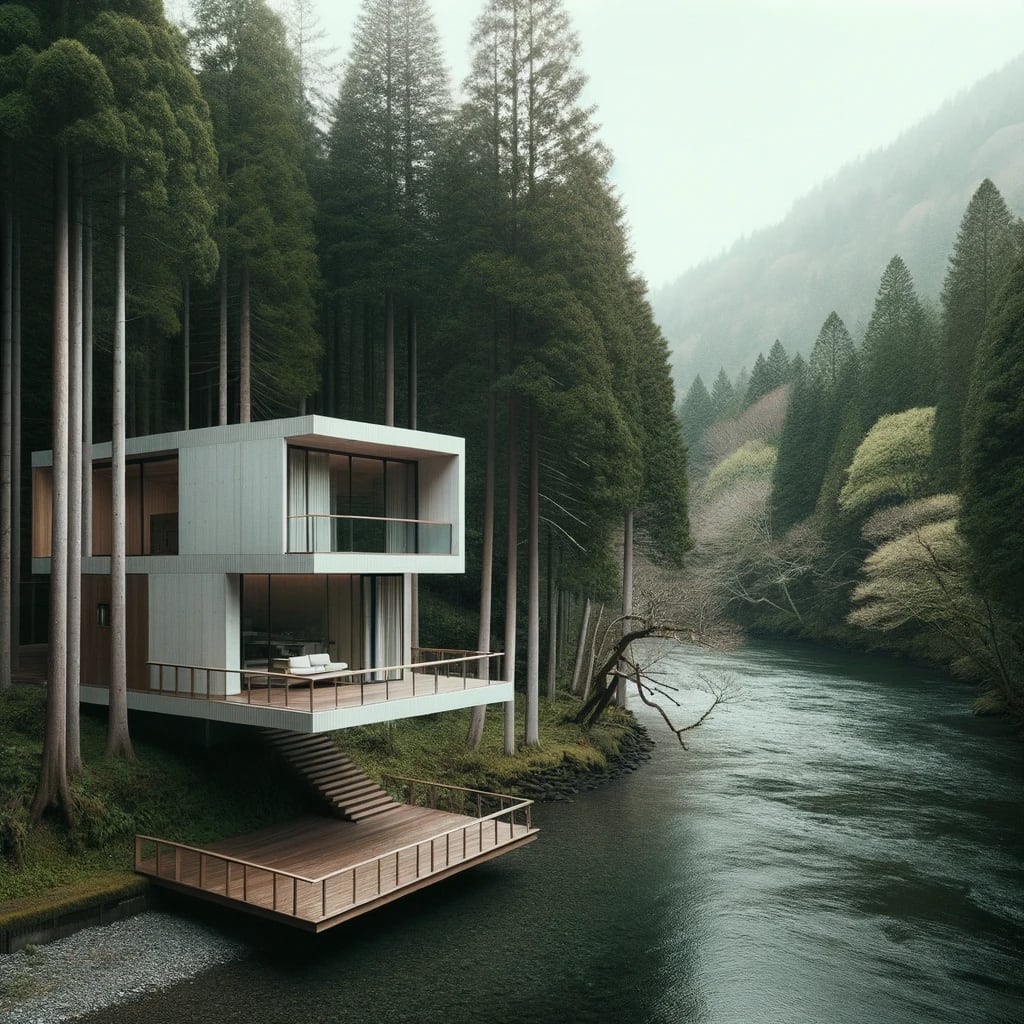
Forested Serenity Villa epitomizes the essence of organic architecture, placing a dwelling within the embrace of towering trees and alongside a tranquil river.
The house’s geometric simplicity is a counterpoint to the complex intricacies of the forest, yet its use of natural materials and elevated positioning showcases a profound respect for the environment.
The design bridges the gap between modern human living and nature’s timeless beauty, creating a space where one can live in peaceful coexistence with the wilderness.
38. Mountain Nest Retreat

Perched atop a cluster of rugged rock formations, the “Mountain Nest Retreat” stands as a testament to the fusion of human ingenuity and nature’s wonders. Its thatched roof and wooden exteriors lend a rustic charm, while the nest-like structures beneath signify a deep connection to the earth and its creatures.
The intertwining roots and branches holding up the living spaces mirror the intricate bonds between humanity and nature. Overlooking the serene valley below, this dwelling offers a tranquil escape, blurring the lines between the built environment and the natural world.
39. Urban Lotus

This building beautifully embodies the principles of organic architecture, where structures are in harmony with their surroundings and human inhabitants. Aptly titled “Urban Lotus” the structure, reminiscent of a blooming flower, is juxtaposed against a backdrop of towering urban residences.
The curvilinear and fluid form of the building draws inspiration from nature, specifically a lotus in full bloom. Surrounded by water, the organic form emphasizes a sense of tranquility amidst the urban hustle, symbolizing a balance between nature and man-made environments.
40. Celestial Spiral
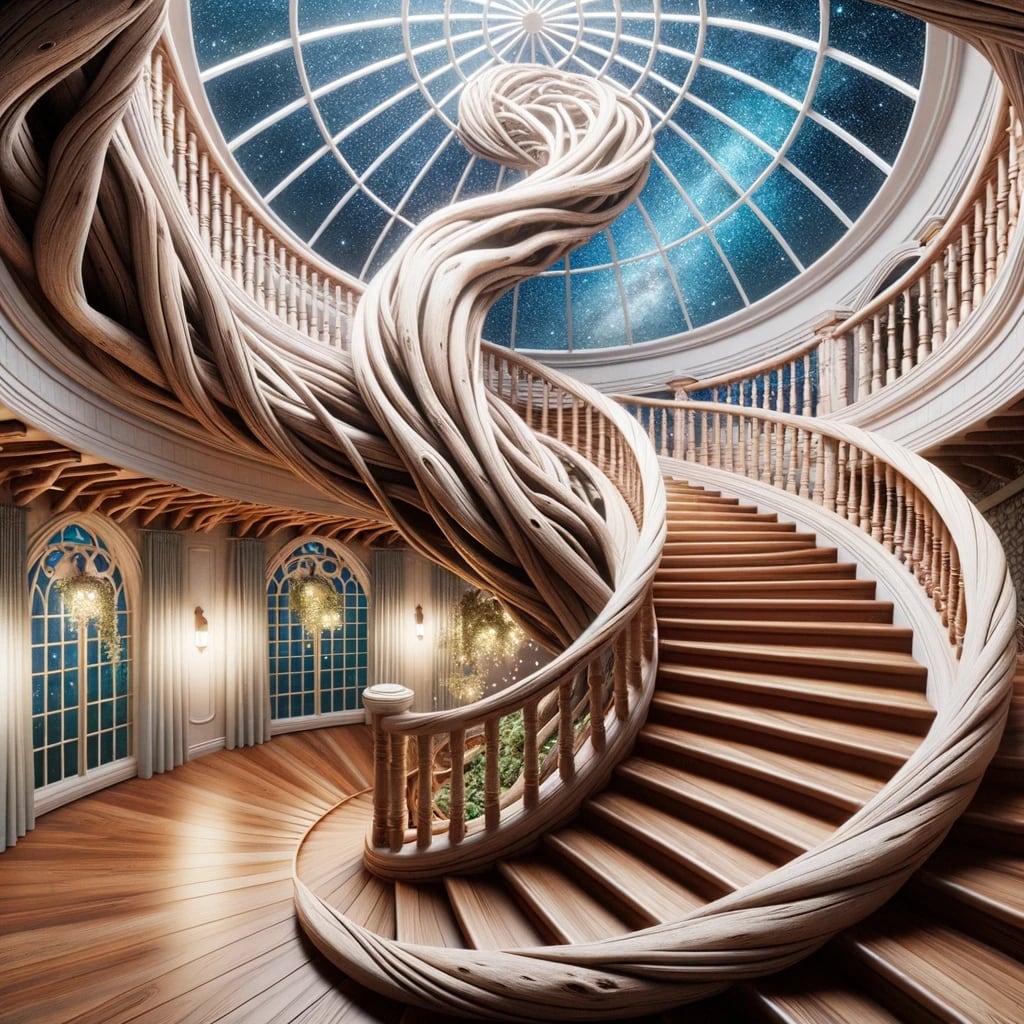
The “Celestial Spiral” showcases a grand staircase that seems to grow and twist organically, much like a vine or the roots of a mighty tree. The centerpiece, a twisting wooden form, ascends towards a domed ceiling adorned with a starry pattern, giving an impression of reaching out to the cosmos.
The integration of natural materials, like wood, with the dreamy, starlit ceiling creates an environment that feels both rooted in the Earth and connected to the universe.
This design is a testament to organic architecture’s ability to merge the tangible with the ethereal, crafting spaces that resonate with our innate connection to the natural world.
41. Ancient Inspirations

This building seamlessly integrates the principles of organic architecture, where the structures are not just built upon the land but are one with it.
The intricate carvings that adorn the exterior walls give a nod to ancient cave drawings, suggesting a harmonious coexistence with nature that dates back centuries.
The reddish-brown hues of the building seem to be extracted directly from the surrounding earth, and the staggered balconies and terraces offer multiple vantage points to take in the verdant surroundings.
42. Mountainous Flow

This breathtaking edifice is a testament to the capabilities of organic architecture. The building’s wavy, curvilinear forms mimic the cascading waterfalls and flowing rivers often found in mountainous terrains.
Set against the backdrop of majestic mountains, the structure appears to grow out from the cliffs themselves, blurring the lines between man-made and natural formations.
The soft gray tone of the building contrasts beautifully with the lush greenery, creating a tranquil and serene environment.
43. Historical Echoes

Embodying the essence of organic architecture, this dwelling seems to rise from the very rocks it’s built upon. Its earthen tones and intricate carvings pay homage to a time gone by, drawing inspiration from ancient petroglyphs and civilization’s early art.
The integration of cascading terraces, open-air spaces, and the seamless blend with the natural rocky surroundings showcase a perfect harmony between the man-made and the environment.
The architecture here isn’t merely a structure on the land; it’s a part of the land, echoing tales of the past while providing modern-day luxury.
Key philosophy in organic architecture
Here are some of the key conceptual foundations behind organic architecture including:
- Design informed by nature
- Buildings as “organisms”
- Wholeness and relationships
- Emergent form
- Sustainability and resilience
Grasping these conceptual underpinnings helps reveal the depth of organic architecture’s vision for integrating architecture and nature through design.
Design Informed by Nature
A core idea in organic architecture is looking to natural forms, systems, and processes as design inspirations. Nature achieves many functions – shelter, temperature regulation, resource efficiency, in remarkably elegant ways.
By studying nature, architects gain principles and strategies that can be translated into built forms. Protective shells, breathable skins, fractal structures, adaptive capacities – nature manages these adeptly. Organic architecture seeks to apply such lessons in building design solutions.
Buildings as “Organisms”
Organic architecture conceives of buildings more as living organisms rather than inert objects. Buildings are dynamic participants within complex environmental systems.
Like organisms, buildings adapt to local climates and conditions. They require nourishment in the form of water, energy, and materials to function. And ultimately buildings have lifespans as they age and one day expire.
Through its name alone, organic architecture prompts a conceptual shift to seeing buildings as living, breathing elements nested within larger habitats.
Wholeness and Relationships
Organic architecture considers wholeness and relationships rather than isolation and division. A structure is one part of a greater living system encompassing site, landscape, climate, culture, economy and more.
Buildings are conceived not as stand-alone objects, but as integrated participants in a much larger context. The conceptual focus becomes relationships between parts rather than the parts in isolation.
Emergent Form
Organic form is not pre-planned, but rather emerges from particular conditions. Site features, environmental factors, needs of inhabitants, construction materials – these details guide form, not the reverse.
Conceptually, organic architecture is against formalism and abstraction for their own sake. Form arises out of tangible needs and conditions rather than arbitrary application.
Sustainability and Resilience
Organic architecture recognizes that nature sustains itself through symbiotic, cyclic systems. Buildings can similarly be designed to cycle water, energy, and materials in a regenerative way.
Drawing conceptual inspiration from ecosystems, organic architecture strives for long-term balance between resource use and renewal. The goal is resilience over time rather than short-term gain.
These conceptual foundations give organic architecture great potential for tackling issues of sustainable and regenerative design. By learning from nature, we can build in greater harmony with natural systems.
Conclusion
Organic architecture has some common traits with biophilic interior design, but applied to architecture.
This approach to architecture design provides a rich foundation for shaping an ecological approach to building. Its vision of architecture as participant within nature, not apart from it, offers wisdom to creating a more sustainable built environment.
While simple in essence, putting these concepts into practice requires great skill and care. But the results can be architecture powerfully tied to place and community.
Related posts:

